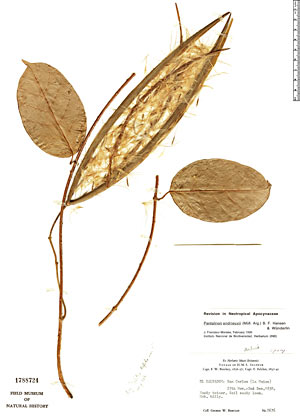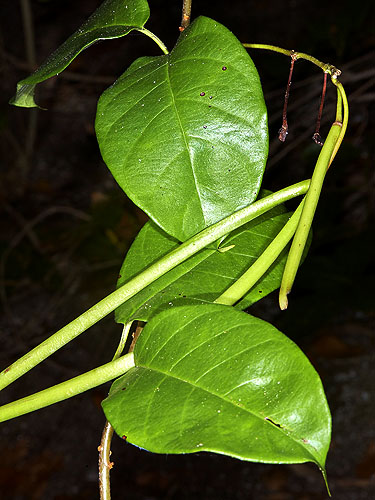Centuries of knowledge explored, exploited and … acknowledged. Should there be more? Do patents trump everything else? Does history mean anything? Does the Convention on Biological Diversity and the Nagoya Protocol on Access and Benefit Sharing mean anything? Does it apply in this situation (the USA is not a signatory to the CBD)? Can it apply with retrospective effect? Should it?
“The roots of the plant Pentalinon andrieuxii have been used by Mayans for years to treat infections from the parasite Leishmania, (Traditional Medicine for Leishmaniasis, The Scientist) …


Pentalinon andrieuxii (Apocynaceae) [looks rather like Wrightia tinctoria, also Apocynaceae]
…and researchers know now why: a compound from the plant, newly synthesized in the lab, reduces parasite load in infected mice.” The Scientist
A novel sterol isolated from a plant used by Mayan traditional healers is effective in treatment of visceral leishmaniasis caused by Leishmania donovani ACS Infectious Diseases. DOI: 10.1021/acsinfecdis.5b00081 Pub. Date (Web): August 31, 2015
Great. Excellent.
And then, the patent:
ANTILEISHMANIAL COMPOSITIONS AND METHODS OF USE
United States Patent Application: 20140287030
Satoskar; Abhay R. ; et al. September 25, 2014
“Pentalinon andrieuxii [(Muell.-Arg.); syn.: Urechites andrieuxii (B. F. Hansen & Wunderlin); Apocynaceae (Muell.-Arg.)], is a native plant in the Yucatan Peninsula of Mexico known as “bejuco guaco”, “cantibteac”, or “contrayerba”. This plant is used in Mayan folk medicine to treat cutaneous leishmaniasis lesions (Chiclero’s ulcer) in the states of Campeche and Quintana Roo, Mexico (Pulido, M. T.; Serralta, L. Centro de Investigaciones de Quintana Roo: Chetumal, Quintana Roo, Mexico, 1993, 6; Argueta, A.; Cano, L.; Rodarte, M. Instituto Nacional Indigenista: Mexico, D. F., 2, 204). Treatment of Chiclero’s ulcer in Mayan traditional medicine uses the innermost part of the roots, which is fixed tightly to the skin lesions. This procedure is repeated each day after careful cleaning of lesions with an infusion of the roots, until visible healing is observed. In addition, this plant may be used also to treat snakebites as well as to alleviate headaches and nervous disturbances (Pulido and Serralta, op. cit.; Argueta, et al., op. cit.).”
Read more: http://www.faqs.org/patents/app/20140287030#ixzz3lorZHtRi
And further: A process patent
METHODS OF ISOLATING THE COMPOUNDS FROM P. ANDRIEUXII
[0155] Pentalinon andrieuxii [(Muell.-Arg.); syn.: Urechites andrieuxii (B. F. Hansen & Wunderlin); Apocynaceae (Muell.-Arg.)], is a native plant in the Yucatan Peninsula of Mexico known as “bejuco guaco”, “cantibteac”, or “contrayerba”. This plant is used in Mayan folk medicine to treat cutaneous leishmaniasis lesions (Chiclero’s ulcer) in the states of Campeche and Quintana Roo, Mexico (Pulido, M. T.; Serralta, L. Centro de Investigaciones de Quintana Roo: Chetumal, Quintana Roo, Mexico, 1993, 6; Argueta, A.; Cano, L.; Rodarte, M. Instituto Nacional Indigenista: Mexico, D. F., 2, 204). Treatment of Chiclero’s ulcer in Mayan traditional medicine uses the innermost part of the roots, which is fixed tightly to the skin lesions. This procedure is repeated each day after careful cleaning of lesions with an infusion of the roots, until visible healing is observed. In addition, this plant may be used also to treat snakebites as well as to alleviate headaches and nervous disturbances (Pulido and Serralta, op. cit.; Argueta, et al., op. cit.). Previous biological studies on extracts of this plant have led to reports of antiatherogenic, anti-inflammatory, antileishmanial, and depressant activities (Jiu, J. Lloydia 1966, 29, 250; Lezama-Davila, C. M.; Isaac-Marquez, A. P. Muell.-Arg. Divulg. Biomed., 1994, 2, 13; Chan-Bacab, M. J.; Balanza, E.; Deharo, E.; Munoz, V.; Duran-Garcia, R.; Pena-Rodriguez, L. M. Journal of Ethnopharmacology 2003, 86, 243; and Lezama-Davila, C. M.; Isaac-Marquez, A. P.; Zamora-Crescencio, P.; c-Encalada, M. R.; Justiniano-Apolinar, S. Y.; Angel-Robles, R.; Satoskar, A.; Hernandez-Rivero, L. Fitoterapia 2007, 78, 255).
[0156] Among these activities, the antileishmanial effect of this plant is of great interest. It has been reported that both aqueous and organic-solvent soluble extractives of P. andrieuxii roots showed in vitro antileishmanial activity, and the most active extract was ascribed to the hexane-soluble partition. A 10 μg/mL extract was effective in killing 1 million L. mexicana promastigotes cultured in vitro, with even more potent leishmanicidal activity than that of the control compound, meglumine antimoniate (Lezama-Davila, C. M.; Isaac-Marquez, A. P.; Zamora-Crescencio, P.; c-Encalada, M. R.; Justiniano-Apolinar, S. Y.; Angel-Robles, R.; Satoskar, A.; Hernandez-Rivero, L. Fitoterapia 2007, 78, 255). Thus far, the phytochemical investigation of this plant is very limited. Cardenolides, flavonoids, and two trinosesquiterpenoids were isolated as secondary metabolites from the roots of P. andrieuxii (Yam-Puc, A.; Escalante-Erosa, F.; Pech-Lopez, M.; Chan-Bacab, M. J.; Arunachalampillai, A.; Wendt, O. F.; Sterner, O.; Pena-Rodriguez, L. M. J. Nat. Prod. 2009, 72, 745), but there are no active principles reported corresponding to the antileishmanial activity of this plant to date. The roots of P. andrieuxii were selected for an activity-guided fractionation following an initial screen for lethal effect on the protozoa of Leishmania mexicana.
[0157] In various aspects, the invention relates to methods of isolating compounds useful as therapeutic agents, which can be useful in the treatment of leishmaniasis and related diseases including, but not limited to malaria, human African trypanomiasis, babesiosis, Chagas disease, microsporidiosis, pneumocystosis, primary ameobic meningoenchephalitis, and toxoplasmosis. The compounds of this invention can be prepared by employing isolation methods as shown in the following schemes (e.g. see FIG. 2 and discussion in “Examples”), in addition to other standard manipulations that are known in the literature, exemplified in the experimental sections or clear to one skilled in the art.
Read more: http://www.faqs.org/patents/app/20140287030#ixzz3nIOvtJbi
